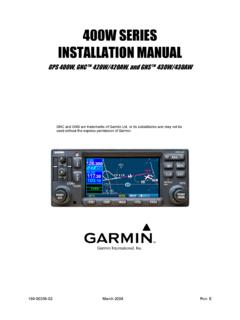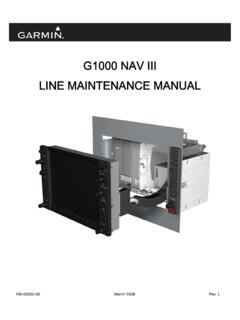Transcription of Fundamentals of Systems Engineering
1 Fundamentals of Systems Engineering Prof. Olivier L. de Weck Session 9 Verification and Validation 1 General Status Update A5 is due next week ! 23 Outline Verification and Validation What is their role? Position in the lifecycle Testing Aircraft flight testing (experimental vs. certification) Spacecraft testing ( shake and bake ) Caveats Technical Risk Management Risk Matrix Iron Triangle in Projects: Cost, Schedule, Scope > Risk System Safety Flight Readiness Review (FRR) 4 Readings related to this lecture NASA/SP-2007-6105 Section (pp. 83-97) Section (pp. 98-105) Appendix E (p. 284) Appendix I (p. 301) Leveson, N., A New Accident Model for Engineering Safer Systems , Safety Science, Vol. 42, No. 4, April 2004 5 Verification and Validation Stakeholder Analysis Set Requirements =Metric + Target value Complete?
2 Intended function Concept Implemented Design Solution Start Model End SE process Solvable? Functional Deployment Model Delivered Function Is goal representative? Validation Validation Loop Consistent? Delivered Goals =Metrics + Delivered value Attainable? Verification Verification Loop Testing 6 Differences between V & V Verification - During development - Check if requirements are met - Typically in the laboratory - Component/subsystem centric Validation - During or after integration -Typically in real or simulated mission environment -Check if stakeholder intent is met - Full-up system Was the end product realized right? Was the right end product realized? This image is in the public Question 9 Answer Concept Question 9 (see supplemental files) 8 Product Verification Process Types of verification -Analysis -Demonstration -Inspection -Test Outputs: -Discrepancy reports -Verified product -Compliance documentation This image is in the public Life-Cycle Phases NASA Life Cycle Phases Project Life Cycle Phases Pre-Phase A: Concept Studies Phase A: Concept & Technology Development Phase B: Preliminary Design & Technology Completion Phase C: Final Design & Fabrication Approval for Implementation FORMULATION IMPLEMENTATION KDP C Project Life Cycle Gates & Major Events Operations Pre- Systems Acquisition Systems Acquisition Phase E: Operations & Sustainment KDP A Launch KDP D Phase D.
3 System Assembly, Int & Test, Launch KDP B Phase F: Closeout Decommissioning End of Mission FOOTNOTES is allowed in the timing, number, and content of reviews as long as the equivalent information is provided at each KDP and the approach is fully documented in the Project Plan. These reviews are conducted by the project for the independent SRB. See Section and Table 2-6. needed for multiple ( 4) system copies. Timing is notional. are established at the discretion of Program Offices. robotic missions, the SRR and the MDR may be combined. ASP and ASM are Agency reviews, not life-cycle reviews. recertification, as required. Plans are baselined at KDP C and are reviewed and updated as required, to ensure project content, cost, and budget remain consistent. Final Archival of Data KDP F SMSR, LRR (LV), FRR (LV)
4 KDP E Peer Reviews, Subsystem PDRs, Subsystem CDRs, and System Reviews DR PLAR MDR4 Robotic Mission Project Reviews1 MCR SRR PDR CERR3 SIR FRR ACRONYMS ASP Acquisition Strategy Planning Meeting ASM Acquisition Strategy Meeting CDR Critical Design Review CERR Critical Events Readiness Review DR Decommissioning Review FAD Formulation Authorization Document FRR Flight Readiness Review KDP Key Decision Point LRR Launch Readiness Review MCR Mission Concept Review MDR Mission Definition Review NAR Non-Advocate Review ORR Operational Readiness Review PDR Preliminary Design Review PFAR Post-Flight Assessment Review PLAR Post-Launch Assessment Review PNAR Preliminary Non-Advocate Review PRR Production Readiness Review SAR System Acceptance Review SDR System Definition Review SIR System Integration Review SMSR Safety and Mission Success
5 Review SRR System Requirements Review FAD Draft Project Requirements Launch Readiness Reviews SDR CDR / PRR2 PDR MCR FRR SRR SIR CERR3 PLAR SAR Human Space Flight Project Reviews1 Re-flights DR (NAR) (PNAR) Supporting Reviews ORR Inspections and Refurbishment Re-enters appropriate life cycle phase if modifications are needed between flights6 End of Flight PFAR Preliminary Project Plan Baseline Project Plan7 ASP5 ORR ASM5 (NAR) (PNAR) CDR / PRR2 Agency Reviews This image is in the public Life-Cycle Reviews ReviewTitlePurposeP/SRRP rogram Requirement ReviewThe P/SRR is used to ensure that the program requirements are properly formulated and correlated with the Agency and mission directorate strategic objectivesP/SDRP rogram Definition Review, orSystem Definition ReviewThe P/SDR ensures the readiness of the program for making a program commitment agreement to approve project formulation startups during program Implementation Concept ReviewThe MCR affirms the mission need and examines the proposed mission s objectives and the concept for meeting those objectivesSRRS ystem Requirement ReviewThe SRR examines the functional and performance requirements defined for the system and the preliminary program or project plan and ensures that the requirements and the selected concept will satisfy the missionMDRM ission Definition ReviewThe MDR examines the proposed requirements, the mission architecture, and the flow down to all functional elements of the mission to ensure that the overall concept is complete, feasible.
6 And consistent with available resourcesSDRS ystem Definition ReviewThe SDR examines the proposed system architecture and design and the flow down to all functional elements of the system. PDRP reliminary Design ReviewThe PDR demonstrates that the preliminary design meets all system requirements with acceptable risk and within the cost and schedule constraints and establishes the basis for proceeding with detailed design. It will show that the correct design options have been selected, interfaces have been identified, and verification methods have been describedCDRC ritical Design reviewThe CDR demonstrates that the maturity of the design is appropriate to support proceeding with full-scale fabrication, assembly, integration, and test. CDR determines that the technical effort is on track to complete the flight and ground system development and mission operations, meeting mission performance requirements within the identified cost and schedule Readiness ReviewA PRR is held for FS&GS projects developing or acquiring multiple or similar Systems greater than three or as determined by the project.
7 The PRR determines the readiness of the system developers to efficiently produce the required number of Systems . It ensures that the production plans; fabrication, assembly, and integration enabling products; and personnel are in place and ready to begin NPR , chapter 3. & Appendix SP-2007-6105, Section This image is in the public of NASA Life-Cycle Reviews (Continued) ReviewTitlePurposeSIRS ystem Integration ReviewAn SIR ensures that the system is ready to be integrated. Segments, components, and subsystems are available and ready to be integrated into the system. Integration facilities, support personnel, and integration plans and procedures are ready for Readiness ReviewA TRR ensures that the test article (hardware/software), test facility, support personnel, and test procedures are ready for testing and data acquisition, reduction, and control.
8 SARS ystem Acceptance ReviewThe SAR verifies the completeness of the specific end products in relation to their expected maturity level and assesses compliance to stakeholder expectations. The SAR examines the system, its end products and documentation, and test data and analyses that support verification. It also ensures that the system has sufficient technical maturity to authorize its shipment to the designated operational facility or launch Readiness ReviewThe ORR examines the actual system characteristics and the procedures used in the system or end product s operation and ensures that all system and support (flight and ground) hardware, software, personnel, procedures, and user documentation accurately reflect the deployed state of the Readiness ReviewThe FRR examines tests, demonstrations, analyses, and audits that determine the system s readiness for a safe and successful flight or launch and for subsequent flight operations.
9 It also ensures that all flight and ground hardware, software, personnel, and procedures are operationally Assessment ReviewA PLAR is a post-deployment evaluation of the readiness of the spacecraft Systems to proceed with full, routine operations. The review evaluates the status, performance, and capabilities of the project evident from the flight operations experience since launch. This can also mean assessing readiness to transfer responsibility from the development organization to the operations organization. The review also evaluates the status of the project plans and the capability to conduct the mission with emphasis on near-term operations and mission-critical events. This review is typically held after the early flight operations and initial Event Readiness ReviewA CERR confirms the project s readiness to execute the mission s critical activities during flight operation.
10 PFARPost-Flight Assessment ReviewThe PFAR evaluates the activities from the flight after recovery. The review identifies all anomalies that occurred during the flight and mission and determines the actions necessary to mitigate or resolve the anomalies for future ReviewA DR confirms the decision to terminate or decommission the system and assesses the readiness of the system for the safe decommissioning and disposal of system assets. NPR , chapter 3. & Appendix SP-2007-6105, Section This image is in the public Verification and Validation What is their role? Position in the lifecycle Testing Aircraft flight testing (experimental vs. certification) Spacecraft testing ( shake and bake ) Caveats Technical Risk Management Risk Matrix Iron Triangle in Projects: Cost, Schedule, Scope > Risk System Safety Flight Readiness Review (FRR) 13 Types of Testing Source: NASA SE Handbook, Section Product Verification This image is in the public Exercise (5 min) What kind of testing have you been involved in in the past?












